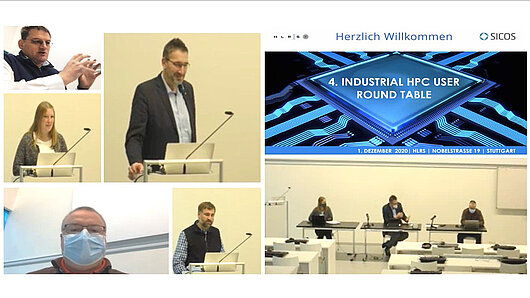High-Performance Computing Center Stuttgart

For the fourth year in a row, SICOS BW and HLRS provided a forum for HPC users from industry to exchange insights about challenges they face when using HPC and simulation. Among the more than 20 participants were representatives of several large corporations, including Airbus, Robert Bosch GmbH, and Porsche AG, as well as many small and medium-sized enterprises (SMEs) from the state of Baden-Württemberg who use HLRS supercomputing resources.
In his keynote presentation Dietmar Krase from Porsche AG explained how the auto manufacturer's development department in Weissach is using HLRS systems. Among other topics, he focused on issues encountered due to interfaces between the different software architectures at the company and HLRS, as well as specific problems the team has encountered in managing the enormous data sets that result from large simulation projects.
During the first part of the virtual round table, participants exchanged insights gathered from their everyday use of high-performance computing, as well as their needs and concerns. Among the key topics discussed were problems resulting from large data sets and remote post-processing, as well as software licensing, cloud computing, and issues related to compatibility between commercial software packages and MPI.
As in past years, Dr. Thomas Bönisch from HLRS reported on the latest developments in HPC technologies and on the support services that the supercomputing center provides for industry clients that use its systems.
The second part of the virtual round table focused on the growing demand for HPC expertise and how this could be addressed through continuing education programs. As part of the discussion, Dr. Andreas Wierse and Nicole Prange of SICOS BW introduced the Supercomputing-Akademie, a training program based at HLRS that aims to increase the level of HPC knowledge and skills in industry.
In the final session, HLRS Director Michael Resch offered an outlook on new kinds of computational approaches that could combine high-performance computing and artificial intelligence. The talk discussed the potential impact of this convergence for scientific research and for the development of new kinds of applications that would benefit industry.
Mark your calendar for December 1, 2021. The next iHURT meeting will once again take place at the High-Performance Computing Center Stuttgart and we hope by that time to be able to meet you in person. Please note that the number of attendees is limited and we reserve the right to select individual participants.
We also welcome suggestions for discussion topics. Contact us at ihurt@sicos.de.